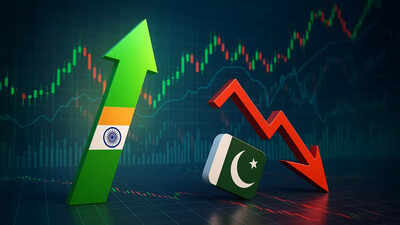India vs. Pakistan: A Dramatic Contrast in Stock Market Resilience
The contrasting reactions of the Indian and Pakistani stock markets to rising geopolitical tensions highlight profound differences in their economic strength. Recent events, particularly the fallout from the Pahalgam terror attack, have showcased just how resilient the Nifty50 is compared to the beleaguered KSE 100.
The Numbers Speak: 245 Times the Size
When we look at market capitalization, the Indian stock market’s valuation dwarfs that of Pakistan’s by an astonishing factor of 245. This impressive figure underlines the structural strength of India’s market, which boasts a market capitalization of approximately $5 trillion, compared to Pakistan’s modest $20.36 billion.

Recent Market Movements: A Tale of Divergence
Nifty50: A Steady Course
In the wake of Operation Sindoor on May 7, the Nifty50 experienced only a minor dip of 1.52%, reflecting its innate stability amidst external pressures. More critically, since the horrific attack in Jammu and Kashmir that resulted in 26 casualties, the Nifty has shown a remarkably resilient trend, retracting only 0.66%.
KSE 100: A Sharp Decline
Conversely, the KSE-100 index has faced a staggering 9.5% drop in the same timeframe. This significant downturn underscores how vulnerable Pakistan’s stock market is to shifts in sentiment, particularly during times of political and social upheaval.
Economic Fundamentals: A Comparative Overview
India: A Powerhouse of Stability
- Market Diversity: With over 5,000 companies listed, India’s market is well-diversified, attracting substantial investment from mutual funds, retail investors, and Systematic Investment Plans (SIPs).
- Robust Reserves: India’s foreign exchange reserves stand at an impressive $688 billion, further solidifying its economic foundation.
Pakistan: The Impact of Limited Scope
- Concentrated Risks: Pakistan’s market, composed of merely 500 companies, offers less protection against market fluctuations, making it disproportionately sensitive to negative news.
- Forex Reserves: The country’s foreign exchange reserves lag significantly at approximately $15.25 billion, straining its economic resilience.
Implications of Geopolitical Tensions
Economic analysts underscore that prolonged military conflict could impose much harsher repercussions on Pakistan’s economy than on India’s. The international credit rating agency, Moody’s, has warned that heightened tensions with India pose significant risks to Pakistan’s economic growth and fiscal stability.
Conclusion: A Market Apart
The divergence between the Indian and Pakistani stock markets serves as a stark reminder of their respective economic landscapes. India’s Nifty50 emerges as a pillar of strength, showcasing resilience even in turbulent political waters. In contrast, the KSE 100 appears increasingly fragile, struggling to maintain stability. As tensions persist, the economic paths of these neighboring nations may continue to diverge, with India poised for growth while Pakistan grapples with vulnerabilities.
For more insights, read about the ongoing India-Pakistan tensions and their broader implications on the regional economy.
Stay Informed
Understanding these market dynamics is essential for investors, policymakers, and anyone interested in the economic landscape of South Asia. Keep an eye on developments, as they will certainly shape the future investment climate in both nations.






